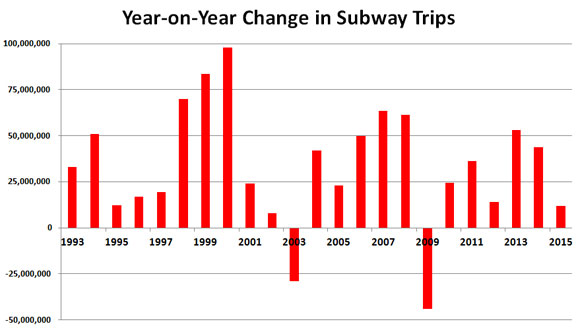Transit officials recently reported that 1,763,000,000 subway trips were taken last year, the most since 1948. But the rise in ridership was meager, with only 12 million more trips in 2015 than in 2014. The percentage growth rate was seven-tenths of one percent. Over the same year, employment in New York City rose three times as fast.
Subway ridership boomed over the prior two decades, rising from 1993 through 2014 at an average annual rate of 34 million trips. During 2013 and 2014 the rate of increase was even higher, averaging 48 million a year, or four times last year’s increase. Measured against those benchmarks, ridership last year fell short by around 30 million trips. At the average effective fare of two bucks, which takes into account price breaks like unlimited farecards, transfers, and senior discounts, NYC Transit lost out on $60 million in revenue in 2015 -- no small sum.
Employment in the five boroughs rose last year by 87,000 jobs, or 2.1 percent, according to the Bureau of Labor Statistics. If half of the additional workers rode the subway to work, their daily commutes would have added nearly 22 million trips to the system. Alternatively, if subway ridership had simply risen as fast as employment, the gain in ridership last year would have been 36 million.
But actual trips rose by only 12 million. Why so little? Transit officials won’t comment until “official” 2015 figures are in. But here are some factors that, in combination, could have suppressed subway use last year.
The fare hike. Transit fares went up last March -- by 10 percent for a single ride, but much less on a trip-weighted basis since 30-day unlimited fares rose just 4 percent. Subway ridership is notoriously price-inelastic, however, and by my calculations the fare increase would have dampened the number of subway trips last year by a modest three-quarters of one percent, or 10 to 15 million. The next biennial fare hike a year from now will likely have a similar effect.
Cheap gas. Pump prices plunged last year; the nearly 30 percent drop was the steepest in at least a half-century, and helped touch off a 3 percent rise in U.S. driving, the biggest in decades. Though I don’t have data, driving presumably increased in our area, with some of the increase coming at transit’s expense. Even if driving here went up only half as much as nationally, and if just half of that increase came at the expense of transit, the hit to 2015 subway ridership would have been another 10 to 15 million trips.
Uber and other on-demand car hires. Uber’s net congestion impacts in the heart of Manhattan may be an unsettled question, but no one disputes that in the rest of the city app-based for-hire vehicles have taken root faster than traditional yellow taxis have lost ground. A graphic published in FiveThirtyEight in December suggests that last year Uber alone was adding a net of 40,000 or more daily pickups by for-hire vehicles outside the Manhattan core. That would translate to 15 million additional vehicle trips last year, many of which might have substituted for the subway.
However, the most worrisome factor in the slow growth of subway ridership, and the hardest to quantify, is crowding. Jammed trains and platforms aren’t just making subway travel more uncomfortable. They're forcing passengers into even closer mutual proximity, enabling misogynist and other antisocial behavior and augmenting the sense of disorder that many New Yorkers associate with the subways. And of course crowding slows riders’ entrance and egress from cars and platforms, increasing station "dwell time" and creating delays that then cascade down the line, sometimes for hours. All of these issues would tend to dampen ridership gains.
Internal MTA data reported to its New York City Transit and Bus Committee show only a 1.3 percentage point increase in late subway arrivals last year, from 21.3 percent in 2014 to 22.6 percent (see p. 19). Yet even last June MTA CEO Tom Prendergast was insisting that "crowding and ridership" caused 40 percent of subway delays in 2014 (see p. 21). Moreover, in both 2014 and 2015, provision of train service by the MTA rose only one-third as fast as ridership (thanks to Steve Bauman for the service figures, which employ a standard transit metric called "train stops"), effectively guaranteeing more crowding and more delays.
It may take another year of flattening ridership before we can say for sure that the subways have stumbled into Yogi Berra territory, where “nobody goes there anymore, it’s too crowded.” What’s already clear is that what Prendergast was calling “the renaissance of the New York City subway... a miracle” just a year ago is now, according to New York Magazine, “a delay crisis.”
Prendergast has finally started to speak out about the unfunded MTA capital plan, telling the MTA board last week that the unprecedented delay, which threatens to halt billions in transit upgrades by mid-year, “is wearing on him,” according to Politico. If the MTA CEO, who serves at the pleasure of the governor, is at last finding his voice, then it’s time for state legislators to join Robert Rodriguez and his 14 Assembly co-sponsors in backing a toll-financing plan that could fill the state funding gap and finance the enhanced subway service needed to enable ridership to continue growing.






